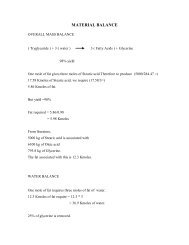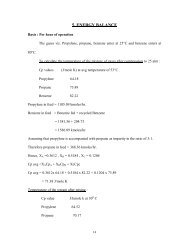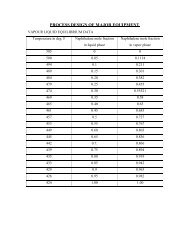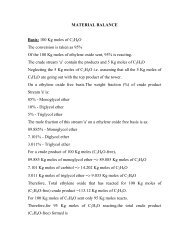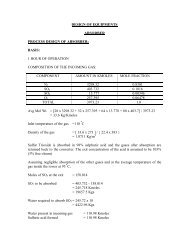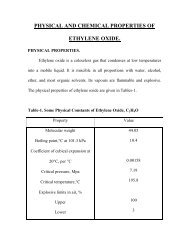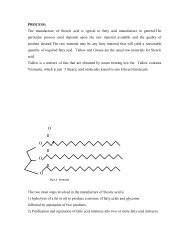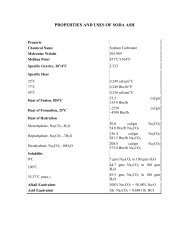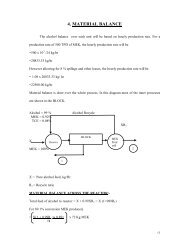Methods of Production
Methods of Production
Methods of Production
You also want an ePaper? Increase the reach of your titles
YUMPU automatically turns print PDFs into web optimized ePapers that Google loves.
MANUFACTURING PROCESES AND SELECTION 1<br />
Many different techniques has been investigated for the manufacture <strong>of</strong> styrene<br />
monomer. Of these, the following methods have been used or seriously considered for<br />
commercial production:<br />
1. dehydrogenation <strong>of</strong> ethyl benzene;<br />
2. oxidation <strong>of</strong> ethyl benzene to ethyl benzene hydro peroxide, which reacts with<br />
propylene oxide, after which the alcohol is dehydrated to styrene<br />
3. oxidative conversion <strong>of</strong> ethyl benzene to ’-phenyl ethanol via acetophenon and<br />
subsequent dehydration <strong>of</strong> alcohol<br />
4. side-chain chlorination <strong>of</strong> ethyl benzene followed by dechlorination<br />
5. side-chain chlorination <strong>of</strong> ethyl benzene ,hydrolysis to the corresponding<br />
alcohols, followed by dehydration<br />
6. Pyrolysis <strong>of</strong> petroleum recovery from various petroleum processes.<br />
The first two methods are only two commercially utilized routes to styrene production.<br />
Method 3 was practiced by Union-Carbide Corporation but later was replaced with a<br />
dehydrogenation process. Method 4 & 5, involving chlorine, have generally been suffered<br />
from high cost <strong>of</strong> the raw materials and from the chlorinated contaminants in the<br />
monomer. Manufacture <strong>of</strong> styrene directly from petroleum streams is difficult and costly.<br />
The two commercially important routes to styrene are based on ethyl benzene production<br />
by alkylation <strong>of</strong> benzene and ethylene .Research programs aimed at replacing expensive<br />
benzene and ethylene feed stocks with less costly alternatives have been carried out by a<br />
number <strong>of</strong> companies.
PROCESS DESCRIPTION 1<br />
OXIDATION PROCESS<br />
One <strong>of</strong> the most notable oxidation processes is Halcon international’s process to<br />
produce styrene from propylene oxide. In this technique, ethyl benzene is oxidized to<br />
hydro peroxide as follows:<br />
C 6 H 5 CH 2 CH 3 + O 2 Æ C 6 H 5 CH(OOH)CH 3<br />
The reaction takes place in the liquid phase with air bubbling through the liquid, and<br />
no catalyst is required. However, since hydro peroxides are unstable compounds,<br />
exposure to high temperature must be minimized to reduce the rate <strong>of</strong> decomposition.<br />
Fewer by-products are formed from the decomposition if the reaction temperature is<br />
gradually reduced during the course <strong>of</strong> reaction, i.e., from 135-160 0 C during the first<br />
half <strong>of</strong> reaction to 125-155 0 C during the second half.<br />
The reaction is more selective to the production <strong>of</strong> by-product acids, when it is carried<br />
out at constant temperature than when the temperature is gradually reduced. In<br />
practice, the temperature is reduced by means <strong>of</strong> a series <strong>of</strong> reactors, each <strong>of</strong> which is<br />
maintained at a progressively lower temperature. The pressure required for the<br />
reaction is not critical; 800-1500 kPa is sufficient to maintain the reactants at liquid<br />
phase.<br />
Reaction is given below:<br />
C 6 H 5 CH(OOH)CH 3 + CH 3 CH=CH 2 Æ C 6 H 5 CH(OH) CH 3 +<br />
CH 3 CH(O)CH 2<br />
Catalysts for this reaction are compounds <strong>of</strong> metals, e.g. molybdenum, tungsten,<br />
vanadium. The epoxidation reaction generally proceeds at 100-130 0 C in the liquid<br />
phase under self-generated pressures. The conversion <strong>of</strong> ethyl benzene hydro peroxide<br />
is nearly complete, and selectivity <strong>of</strong> the reaction in producing propylene oxide is
greater than 70%. The alcohol can be dehydrated to styrene or it is reduced to ethyl<br />
benzene for recycle if styrene is not desired.<br />
Montoro, a Spanish joint venture between Oxirane and Enpetrol, first commercializes<br />
the process in 1973. The plant had an annual capacity <strong>of</strong> 7.5*10 4 ton <strong>of</strong> styrene and<br />
3*10 4 ton <strong>of</strong> propylene oxide. The Oxirane plant in Channelview, Texas, set up in<br />
1977 had a capacity <strong>of</strong> 2.25*10 5 ton annual production.<br />
DEHYDROGENATION OF ETHYL-BENZENE<br />
REACTION:<br />
C 6 H 5 CH 2 CH 3 Æ C 6 H 5 CH=CH 3 + H 2 + (û+ R )<br />
Several licensed process are available for the conversion <strong>of</strong> ethyl-benzene to styrene.<br />
Although all such processes share the catalytic dehydrogenation <strong>of</strong> ethyl benzene to<br />
styrene in the presence <strong>of</strong> steam, there are two distinct approaches to the reaction<br />
section design: the adiabatic process and the isothermal process. As the<br />
dehydrogenation reaction is endothermic, requiring 1.26-1.33 MJ/kg <strong>of</strong> ethyl benzene<br />
converted at 25 0 C, heat must be supplied. In the adiabatic process, steam superheated<br />
to 800-950 0 C is mixed with preheated ethyl benzene (EB) feed prior to exposure to the<br />
catalyst. The isothermal process takes place in PFR and reaction heat is provided by<br />
indirect heat exchange between the process fluid and a suitable heat transfer medium,<br />
e.g., flue gas (BASF technology).<br />
For a given dehydrogenation catalyst, the catalyst life , the molar conversion <strong>of</strong> ethyl<br />
benzene, and the molar selectivity <strong>of</strong> ethyl benzene to styrene are effected by reactor<br />
operating pressure, molar steam to hydrocarbon ratio , reactor operating temp. and reactor<br />
liquid hourly space velocity (LHSV) . For all catalysts, there is a compromise between<br />
activity, otherwise EB conversion, and styrene selectivity.
Because the dehydrogenation reaction produces 2 moles <strong>of</strong> products otherwise styrene &<br />
Hydrogen , for every mole <strong>of</strong> reactant , i.e., EB ,the desired reaction course can be<br />
enhanced by adding steam to the reactor system to reduce the styrene partial pressure in<br />
the reactor and /or by reducing the reactor operating pressure.<br />
As these increase conversion or other refinements and approaches equilibrium, the rate<br />
<strong>of</strong> the main reaction slows down but the rates <strong>of</strong> undesired side reactions do not.<br />
Adiabatic operating pressures were generally about 138 kPa with molar steam to<br />
hydrocarbon ratio above 14:1. For the isothermal reactor designs, it is maintained at 6-<br />
8:1.<br />
Since the reaction is endothermic with increase in temperature, conversion also<br />
increases. However, an upper limit to reactor temp ; when temp are increased above<br />
610 0 C ,thermal cracking <strong>of</strong> EB & styrene occurs , since in isothermal process the temp<br />
maintained at 580-610 0 C across the catalyst bed, where in adiabatic reactor the feed<br />
mixture generally introduced at 660-610 0 C .Decreasing the residence time in the<br />
adiabatic process reduces the potential selectivity over isothermal process.<br />
As for LHSV, molar conversion <strong>of</strong> EB is an inverse function <strong>of</strong> this parameter since<br />
higher velocities mean lower residence time. This in turn reduces molar conversion.<br />
For adiabatic reactors designed LHSVs <strong>of</strong> .4-.6 m 3 /hr EB per cubic meter <strong>of</strong> catalyst.<br />
Within this range , a 60-70% molar conversion <strong>of</strong> EB and a 90-95% molar selectivity<br />
<strong>of</strong> EB to styrene can be achieved with commercially available dehydrogenation .It is<br />
believed that similar results are obtained with the isothermal process.<br />
The main difference between the isothermal and adiabatic processes is in the way the<br />
endothermic reaction heat is supplied. In principle, the isothermal reactor is designed<br />
like a shell& tube H.E.: a fixed bed dehydrogenation catalyst and reactant gas is on the<br />
tube side, & a suitable heat transfer medium is on the shell side. The diameter <strong>of</strong> the<br />
self-contained reactor tubes are 10-20 cm and the lengths are 2.4-3.7m .All<br />
commercial catalysts are formulated around an iron oxide base inherent to this ferric<br />
compound is the reduction to lower oxides at the dehydrogenation reaction<br />
temperature. The most widely used additives are chromic oxide as the stabilizer and
potassium oxide as the coke retardants. Thus, the catalyst is self-regenerative, there by<br />
allowing such residues to built up to an equilibrium level.<br />
One difference between licensed adiabatic technologies is in the configuration <strong>of</strong> the<br />
dehydrogenation reactor, e.g., instead <strong>of</strong> a radial–flow reactor, a fixed-bed axial reactor<br />
may be employed. Another difference in technologies is in the reactor feed heat<br />
exchanger section. Instead <strong>of</strong> only steam passing through a fired heater, all <strong>of</strong> the EB and<br />
vaporization/dilution is combined with the mixture is raised to the reaction temp in a fired<br />
heater. Although similar in concept, the process involves heating the steam and EB in<br />
separate coils <strong>of</strong> a fired heater. As temperatures well above 850 0 C may be encountered<br />
with both processes, the potential for thermal cracking <strong>of</strong> EB is increased. Therefore, the<br />
residence time in heater should be minimized.<br />
PURIFICATION<br />
To obtain the desired product, crude styrene effluent from the reaction section must be<br />
fractionated and undesirable by-products are removed. To minimize the<br />
polymerization <strong>of</strong> vinyl aromatic compounds, low temp vacuum distillation <strong>of</strong> the<br />
crude styrene is necessary. Further reduction in polymerization is obtained by<br />
employing inhibitors. Inhibitors were used as extensively polymerization reductant.<br />
The main nonsulfur inhibitors are nitrogen-substituted aromatics, e.g., nitro-phenols.<br />
The most commonly used commercial inhibitor for this service 4-tert-butylcetahol.<br />
The entire purification section is composed <strong>of</strong> three vacuum fractionators in series. In<br />
the first column benzene& toluene impurities are been separated from the crude<br />
styrene. The next column is EB recycle column, here unreacted EB been recovered<br />
and fed back to the reactor. The separation <strong>of</strong> EB from styrene is difficult because they<br />
have a very close boiling point. High efficiency, low-pressure distillation column are<br />
used. However, extensive effort is being made to commercialize the use <strong>of</strong> packing for<br />
this purpose. Such approach <strong>of</strong>fers significant reduction in pressure drop.<br />
The bottom stream from the EB recycle stream is been fed to the final styrene<br />
purification column. The feed stream to the final purification column contains EB at a<br />
concentration <strong>of</strong> 1000 ppm. High purity product <strong>of</strong> styrene is obtained as the distillate<br />
and send to storage.
FLOW SHEET OF THE STYRENE PLANT
PRE -<br />
HEATER<br />
ADIABATIC REACTOR<br />
1<br />
S<br />
E<br />
P<br />
E<br />
R<br />
A<br />
T<br />
O<br />
R<br />
B<br />
E<br />
N<br />
Z<br />
E<br />
N<br />
E-<br />
T<br />
O<br />
L<br />
U<br />
E<br />
N<br />
E<br />
T<br />
O<br />
W<br />
E<br />
EBR<br />
ECY<br />
CLE<br />
F<br />
I<br />
N<br />
A<br />
L<br />
P<br />
U<br />
R<br />
I<br />
F<br />
I<br />
E<br />
R<br />
FINAL<br />
PURIFIED<br />
ETHYL<br />
BEZENE<br />
PURE ETHYL<br />
BENZENE<br />
1= CONDESER<br />
2=REBOILER<br />
HYDROGEN<br />
GAS
HEALTH AND SAFETY 1<br />
Styrene is mildly toxic and inflammable, and it can polymerize violently under specific<br />
conditions. However, none <strong>of</strong> the hazard associate with styrene is severe, and it is<br />
considered a relatively safe organic chemical when handled according to appropriate safe<br />
guards.<br />
Styrene has an odor threshold <strong>of</strong> .05-.15 ppmv. Both liquid and vapor irritate the eye and<br />
respiratory system, and high vapor concentration results in depression <strong>of</strong> central nervous<br />
system.<br />
Irritation <strong>of</strong> eye and respiratory tract occurs at 400-500 ppmv, but does not result in<br />
permanent injury. Test animals for one hr serious systematic effects can tolerate<br />
concentration up to 2500 ppmv. Exposure for 30-40 min to a conc. <strong>of</strong> 10000 ppmv may<br />
be fatal.<br />
Styrene is low in oral toxicity. Contact with eyes is painful, but results in transient<br />
damage. Short term contact with skin, do not cause irritation; however prolonged contact<br />
may cause swelling, blistering. However, styrene as it is commonly store and transported<br />
contains TBC, which is skin sensitizer. Styrene monomer is flammable and can form<br />
explosive mixture with air at atmospheric ambient condition. It is generally suggested to<br />
store & handle styrene below or at atmospheric temp.<br />
Polymerization <strong>of</strong> styrene is an exothermic reaction and proceeds slowly at room<br />
temperature. Thus, there is potential for a runaway polymerization reaction, which may<br />
results in an accelerating evolution <strong>of</strong> styrene vapor that may cause fire or rupture in the<br />
confining vessel. The polymerization reaction is generally been prevented by adding TBC<br />
inhibitor.<br />
Effective inhibition <strong>of</strong> polymerization by TBC occurs in presence <strong>of</strong> dissolved oxygen,<br />
and so storage in an atmosphere-permeable tank is preferred, where inert gas blanketing<br />
<strong>of</strong> the stored material is to be done. Periodic air addition is recommended to maintain the<br />
presence <strong>of</strong> dissolved oxygen.
For the areas, where, average temperature is over 27 o C, additional refrigeration is<br />
required.<br />
MEASURES:<br />
• The efficiency <strong>of</strong> the, condenser should must be properly justified, so that<br />
there be minimum loss <strong>of</strong> styrene in the atmosphere.<br />
• The reactor is generally made adiabatic, and the reaction is endothermic. The<br />
heat <strong>of</strong> reaction is generally supplied by adding steam at 800 o C. This steam is<br />
then condensed and separated as an aqueous solution, saturated with different<br />
organic chemical. To maintain the proper industrial economy, this condensate<br />
must be treated and recycled back at maximum possible limit.<br />
• The heavy end from the final column, contain styrene polymers and some<br />
styrene derivatives, which have good economical values. However, disposal <strong>of</strong><br />
this heavy end causes problem. So by adopting proper separation method it is<br />
desired to separate those components <strong>of</strong> high economical values.<br />
• In order to prevent the chance polymerization, final treatments are generally<br />
carried out under reduced temperature and low pressure.




